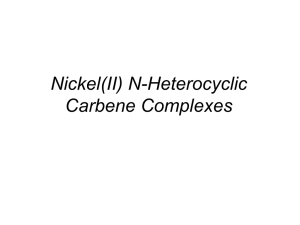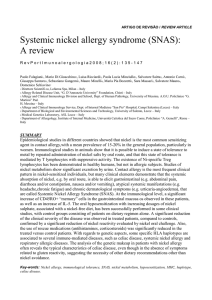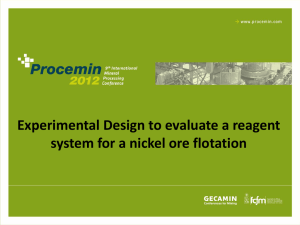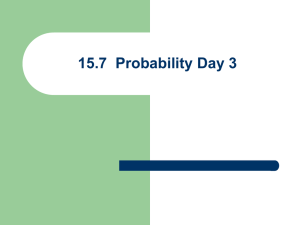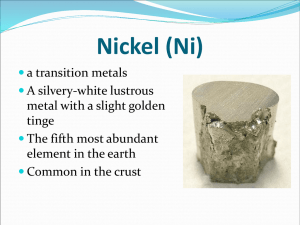Treatment of wastewaters containing toxic metals (nickel)
advertisement
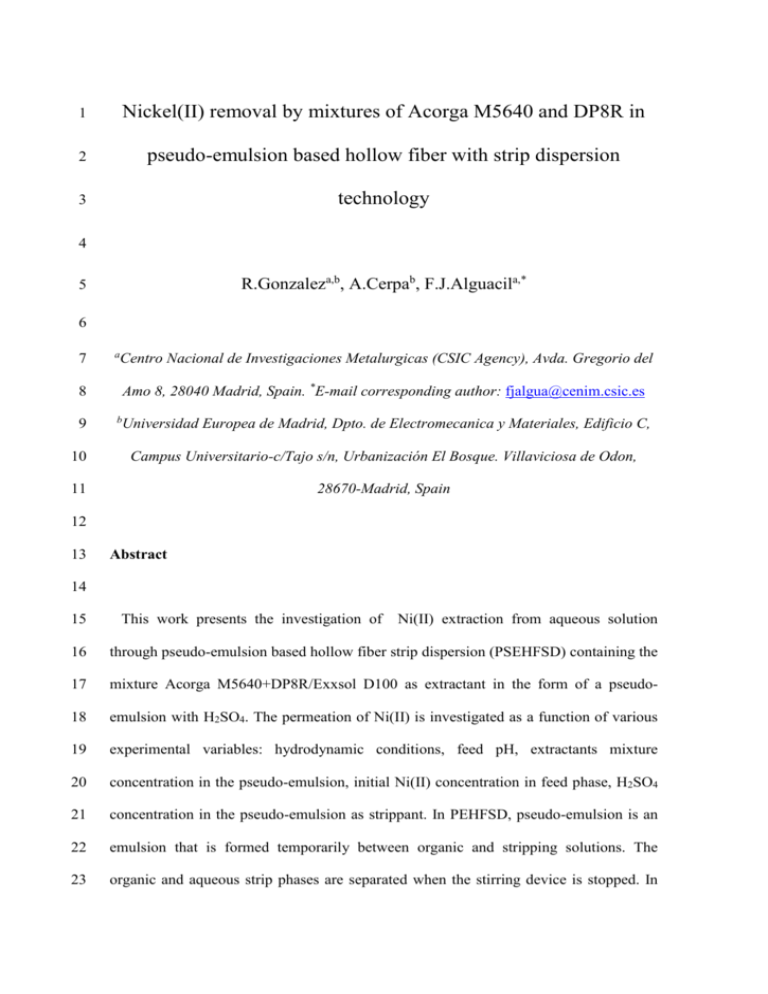
1 Nickel(II) removal by mixtures of Acorga M5640 and DP8R in 2 pseudo-emulsion based hollow fiber with strip dispersion 3 technology 4 R.Gonzaleza,b, A.Cerpab, F.J.Alguacila,* 5 6 7 a Centro Nacional de Investigaciones Metalurgicas (CSIC Agency), Avda. Gregorio del Amo 8, 28040 Madrid, Spain. *E-mail corresponding author: fjalgua@cenim.csic.es 8 9 b Universidad Europea de Madrid, Dpto. de Electromecanica y Materiales, Edificio C, 10 Campus Universitario-c/Tajo s/n, Urbanización El Bosque. Villaviciosa de Odon, 11 28670-Madrid, Spain 12 13 Abstract 14 15 This work presents the investigation of Ni(II) extraction from aqueous solution 16 through pseudo-emulsion based hollow fiber strip dispersion (PSEHFSD) containing the 17 mixture Acorga M5640+DP8R/Exxsol D100 as extractant in the form of a pseudo- 18 emulsion with H2SO4. The permeation of Ni(II) is investigated as a function of various 19 experimental variables: hydrodynamic conditions, feed pH, extractants mixture 20 concentration in the pseudo-emulsion, initial Ni(II) concentration in feed phase, H2SO4 21 concentration in the pseudo-emulsion as strippant. In PEHFSD, pseudo-emulsion is an 22 emulsion that is formed temporarily between organic and stripping solutions. The 23 organic and aqueous strip phases are separated when the stirring device is stopped. In 2 24 this investigation, feed was circulated through the lumen side in counter-current mode. 25 The selectivity of Acorga M5640+DP8R/Exxsol D100 based PEHFSD toward different 26 metals was also examined. 27 28 Keywords: Nickel (II); Pseudo-emulsion hollow fiber strip dispersion; Acorga M5640; 29 DP8R; Metal transport; Wastewater treatment 30 31 32 1. Introduction 33 34 Over the past decades, membrane technology has led to important innovations either 35 in the processing and in products specially when it was refereeing to sustainable 36 industrial growth. 37 Membrane technology and its inherent accompanying science has been demonstrate in 38 a wide range of applications including: metal ion extraction, wastewater treatment, 39 fermentation, pharmaceuticals, etc. (Pabby et al., 2008). 40 Including in this science and technology, liquid membranes (LMs) have offered their 41 potentials and among them, supported liquid membranes (SLMs), in whatever its 42 configuration, are constantly under theoretical and practical consideration. Thus, the 43 removal of metals from dilute or even concentrate solutions, using this technology, has 44 received a considerable attention for the recovery of valuable metals or decontamination 45 of liquid effluents. 46 Though LMs and SLMs variations offered their attraction, some of the problems 47 encountered in their use, specially their apparent lack of stability, had led to a less 3 48 frequent scaling-up of such membrane processing. Thus, modifications and 49 improvements are needed continuously, specially when refereed to find a more stable 50 technology. In this context, non-dispersive solvent extraction (NDSX) (Kumar et al, 51 2002), supported liquid membrane with strip dispersion (SLMSD) (Ho, 2003), and 52 hollow fiber renewal liquid membrane (HFRLM) (Ren et al., 2008) had been developed 53 in order to find a suitable technology for practical use. All the three above can be 54 operated using a hollow fiber contactor which gives a high surface area to volume ratio, 55 and whereas stripping is performed in NDSX in a second module, both SLMSD and 56 HFRLM perform the stripping in a single hollow fiber contactor. 57 Being nickel a metal widely used in the industry and currently reaching elevated 58 prices, it is also one of the metals which appeared in liquid streams. In surface waters, 59 this element arises from runoff from soil and tailing pipes, from atmospheric deposition 60 and from landfill leachates. Industrial and municipal wastewater is another important 61 source of nickel in surface waters. Leaching of nickel from soil into groundwater 62 accounts for much of the element found in these waters being this process probably 63 accelerated in regions in which acid precipitation occurs. Nickel absorption for humans 64 is higher when the element is present in drinking water as opposed to food, and though 65 there is not an apparent EPA-mandated legal limit of amount of nickel in drinking 66 water, the recommendation of the agency for the maximum contaminated level (MCL) 67 is 0.1 mg Ni per liter of drinking water. The toxicological character of nickel to humans 68 is that its ingestion is consistently associated, among others, with lung and 69 nasopharyngeal cancer (Sutherland and Costa, 2002). 70 Various technologies were used to remove nickel from aqueous solutions, i.e. solvent 71 extraction, LMs, and ion exchange resins (Algarra et al., 2005; Alguacil et al., 2006; 4 72 Amini et al., 2009; Argun, 2008; Bukhari, et al., 2006; Cerpa and Alguacil, 2004; 73 Cheng, 2006; Dabrowski et al., 2004; Dimitrov et al., 2008; Egorov et al., 2010; Jung et 74 al., 2008; Kandah and Meunier, 2007; Molinari et al., 2008; Ortiz et al, 2001; Reddy 75 and Priya, 2006; Tanaka et al, 2008; Van der Voorde et al., 2004; Wilson et al., 2006; 76 Yang and Cussler, 2000). 77 The prime objective of this investigation is to study Ni(II)/Acorga M5640+DP8R in 78 relation to several experimental variables: hydrodynamic conditions, pH of feed, 79 extractants Acorga M5640 and DP8R concentrations in Exxsol D100, Ni(II) 80 concentration in feed solution, etc., by pseudo-emulsion based hollow fiber strip 81 dispersion technology using a single module for extraction as well as stripping. In 82 addition mass transfer parameters were estimated and the selectivity of Ni(II) against 83 metals such as Co(II), Fe(III) and Cr(III) was also evaluated. 84 85 2. Experimental 86 2.1. Materials 87 The active substance of DP8R is di(2-ethylhexyl) phosphoric acid, whereas the active 88 substance of Acorga M5640 is 2-hydroxy-5-nonylbenzaldehyde oxime to which a fatty 89 ester is added as a modifier. 90 DP8R and Acorga M5640 extractants were supplied by Daihachi and Avecia, 91 respectively. Both reagents were used as supplied by the manufacturers as also did with 92 Exssol D100 diluent (ExxonMobil) containing >99% aliphatics. 93 All other chemicals used in the present study were of AR grade. 94 95 2.2. Hollow fiber apparatus used for PEHFSD, preparation and methods 5 96 The hollow fiber device (Liqui-cel 8x28 cm 5PCG-259 LLE contactor and 5PCS- 97 1002 Liqui-Cel LLE unit) used for experimentation was a commercially available unit 98 from Celgard (now Membrana). The module details and hollow fiber membrane 99 characteristics were given elsewhere (Kumar et al., 2005). 100 The hollow fiber strip dispersion process comprises one membrane module for 101 extraction and stripping, one stirred tank for preparing a pseudo-emulsion of Acorga 102 M5640+DP-8R/Exxsol D100 and H2SO4, and a supplementary second tank which 103 contained the feed solution homogenized by gentle stir. The experimental set-up for the 104 separation of the metal consists of two gear pumps of varying flows for both phases. 105 The organic phase wet the porous wall of the fiber because of its hydrophobic nature. 106 The interface was maintained at the pore by applying a higher pressure to the feed phase 107 than to the pseudo-emulsion solution, thus, in the feed phase the pressure was 108 maintained 0.2 bar higher than in the pseudo-emulsion phase. The differential pressure 109 was always kept below the breakthrough pressure. 110 The view of PEHFSD using a single hollow fiber contactor in the recirculation mode 111 is shown in Figure 1. The PEHFSD operation was carried out by passing the feed 112 solution containing nickel (II) through the tube side and the pseudo-emulsion through 113 the shell side in counter-current mode. The pseudo-emulsion was prepared by mixing in 114 the corresponding tank, the organic and strip solutions, being the latter dispersed into 115 the organic phase. The stirring rate in this tank was kept below 500 rpm, this stirring 116 speed was fixed as best suited for this experimentation. The character of the pseudo- 117 emulsion may be such that it should have clear and fast phase separation (organic and 118 strippant phases) when the mixing is stopped. The recovery of nickel from pseudo- 6 119 emulsion can be accomplished (pseudo-emulsion breaks down in about 30 seconds after 120 the mixing of phases stopped) and strip and organic phases separated automatically. 121 The volume of pseudo-emulsion phase is 800 cm3 (400 cm3 of Acorga 122 M5640+DP8R/Exxsol D100 and 400 cm3 of H2SO4 solution); 3000 cm3 of feed solution 123 of the desired Ni(II) concentration was prepared by taking a suitable aliquot of the 124 nickel sulphate stock solution. Further, the desired feed pH was adjusted and controlled 125 by adding small aliquots of H2SO4 or NaOH solution. 126 127 At predetermined time, aliquots of the aqueous phases were taken and analyzed for metal concentration by AAS. 128 129 3. Results and discussion 130 For extraction of Ni(II) by PEHFSD containing DP8R (HL) and Acorga M5640 (HR) 131 as mobile carrier, the concentration profile across the hollow fiber membrane pores in 132 the contactor is schematically shown in Figure 2. The nickel (II) ions in the aqueous 133 solution complex with the extractants dissolved in the suitable diluent. 134 135 The extraction equilibrium is expressed as (Alguacil, 2002): 2 Ni aq pH 2 L 2 org qHR ) org NiL 2 p R q H 2 p q 2 org 2H aq (1) 136 which is related to a cation exchange reaction, and where p can be 2 or 4 depending of 137 the extractant concentration and q is 2. The extracted complex then diffuses through the 138 pore of the hollow fiber toward the membrane pseudo-emulsion interface, where nickel 139 is stripped in the pseudo-emulsion phase after coming into contact with H2SO4. This 140 reaction, in which the above equilibrium is shifted to the left, is fast and instantaneous. 141 At the same time, the carrier is regenerated and diffuses back through the hollow fiber, 142 after which the process is repeated. Such a process is called counter-transport, where the 7 143 difference in H+ concentration between the feed and the strip solutions is used as the 144 driving force for nickel transport. 145 In the case of PEHFSD, calculation of the overall permeability coefficient of the 146 experimental system is based on a first-order mass transfer equation with instantaneous 147 chemical reaction in the stripping side when a recycling mode is operated. 148 The transport of nickel across the liquid membrane can be described by considering 149 only diffusional parameters. The interfacial transport of Ni(II) due to the chemical 150 reaction has been neglected as the chemical reactions seem to take place at the feed 151 solution-membrane and membrane-pseudo-emulsion phase interfaces, and it had been 152 previously suggested that chemical reactions occur simultaneously relative to the 153 diffusion process (Zuo et al, 1996; Alguacil and Alonso, 2003; Juang and Huang, 2003). 154 The transport of Ni(II) in a hollow fiber membrane system operating in the recycling 155 mode can be explain by consideration of equations which described i) the change of 156 metal concentration in the feed and stripping streams when are circulating through the 157 hollow fiber module and ii) the change of metal concentration in the feed and stripping 158 tanks when the aqueous solutions are continuously recirculated. Also, linear 159 concentration gradient and absence of back-mixing are assumed. 160 161 162 Accordingly (Kumar et al, 2000), experimental results can thus be fitted to a firstorder kinetic law: VFEED ln Nit Ni0 S t (2) 163 where S is a factor dependent on the geometry of the fibers and the module, the linear 164 velocity of the fluids, and the overall permeability of the system. This last value, PNi, 165 can be obtained by the following relation: 8 PNi 166 S ri v FEED 2 r L N v FEED S L (3) 2 i 167 where N, L, ri, ε (membrane porosity) and vFEED are known values dependent of the 168 module characteristics (N, L, ri, ε), and vFEED is the experimental feed linear flow 169 velocity. 170 The separation-concentration of nickel using the hollow fiber module and overall 171 permeation coefficient center on three mass transfer resistances. One occurs in the 172 liquid flowing through the hollow fiber lumen. The second correspond to the nickel- 173 complex diffusion across the liquid membrane immobilized in the porous wall of the 174 fiber. The third resistance is due to the aqueous interface created on the outside of the 175 fiber. 176 The reciprocal of the overall permeability coefficient is given by: r 1 ri 1 1 1 i PNi k i rlm Pm ro k o 177 178 179 180 181 182 (4) The membrane permeability is related to the partition coefficient of nickel (DNi) with the mixture Acorga M5640+DP8R via eq. (1): H L HR Pm D Ni k m K ext H 2 aq 2 p 2 org q org km (5) where DNi is defined as: D Ni NiL 2p R q H 2 p q 2 org Ni 2 (6) aq 183 Inserting eq.(5) in eq.(4), and if the reaction is instantaneous on the stripping side, the 184 contribution of the outer phase is removed from eq. (4) and: 2 185 H aq ri 1 1 p q PNi k i rlm k m K ext H 2 L 2 org HR org (7) 9 186 187 3.1. Influence of flow rate on nickel transport 188 Table 1 showed the effect of different feed flows for testing 0.01 g L-1 concentrations 189 of Ni(II) using 10% v/v DP8R+10% v/v Acorga M5640/Exxsol D100. PNi values 190 increased with increasing the flow of the feed phase up to 280 cm3 min-1 and further 191 decreased at a flow rate of 360 cm3 min-1. As expected, PNi first increased with flow and 192 then decreased. The increase of PNi with the flow is caused by a decrease of the 193 thickness of the aqueous boundary layer when the flow in the fiber lumen increased, 194 whereas the decrease in PNi value could be lower residence time at higher flow rate, 195 which provides insufficient time to complex Ni(II) with the carriers. This resulted in 196 incomplete loading of the extractants with nickel, which finally contributed to the lower 197 value of PNi. In this experimental study, it was necessary to maintain the interface in the 198 pore of the fiber mouth. To avoid the problem of the contamination of feed phase by the 199 pseudo-emulsion at the highest flow rate, the 280 cm3 min-1 flow rate is selected for 200 further investigations. The importance of pressure control across the tube sides of the 201 contactor is described elsewhere (Sonawane et al., 2008). 202 203 3.2. Influence of H2SO4 concentration in the strip phase on metal transport 204 To study the influence of the sulphuric acid concentration in the stripping solution on 205 the transport of nickel, a series of experiments were conducted using feed phase of 0.01 206 g L-1 Ni(II) at pH 4.0±0.1, an organic solution of 10% v/v DP-8R+10% v/v Acorga 207 M5640/Exxsol D100 and strip phases containing 0.5-2 M H2SO4. Results obtained 208 indicated that the variation in the H2SO4 concentration in the strip phase has no 209 influence on metal permeation, with PNi values very close to 4.4x10-4 cm s-1. On the 10 210 other hand, the variation of the H2SO4 concentration in the strip phase has also a minor 211 effect on the percentage of nickel recovered in this phase. 212 213 3.3. Influence of initial metal concentration on Ni(II) transport 214 Studying the effect of the initial concentration of nickel (II) (0.01-3.6 g L-1) in the feed 215 phase, when the stripping solution contains no nickel, it was revealed that the metal 216 permeation continuously decreased as the initial metal concentration increased in the 217 feed phase. The results of nickel permeation through the fibers as a function of the 218 initial metal concentration are shown in Figure 3, indicating that the concentration limit 219 for the proper function of the technology is below 0.4 g L-1 Ni(II) in the feed phase.. 220 This behaviour can be related to that within the present range of nickel concentrations 221 used, the transport process is controlled by diffusion of nickel species. The interfacial 222 transport of Ni(II) seem to take place at the feed solution/fiber and fiber/pseudo- 223 emulsion interfaces. As it was mentioned above, chemical reactions occur at the same 224 time to the diffusion process. Thus, the nickel(II) transport rate is determined by the 225 diffusion rate of nickel that contains species across the aqueous feed diffusion layer and 226 by the diffusion rate of Ni(II)/Acorga M5640+DP8R complexes through the fibers. The 227 decrease in transport at higher nickel concentrations in the feed solution could be further 228 enhanced either by increasing the surface area of the contactor or running the operation 229 for longer time. 230 231 3.4. Effect of feed phase pH on the transport of nickel (II) 232 In the present PEHFSD system, the pH gradient between the feed and the stripping 233 solutions is the driving force for the transport of metal ion. To asses the role of this 11 234 variable, pH variation studies in the range 2.0-5-0±0.1 were carried out. The stripping 235 solution consisted of 1 M H2SO4, whereas the concentration of the organic solution was 236 10% v/v DP8R+10% v/v Acorga M5640/Exxsol D100. It is evident from Table 2 that 237 the metal permeability increases with an increase in pH from 2.0 to 4.0, though at 238 higher pH it remained unaffected. Thus, it is considered that the pH value of 4.0 may be 239 optimum for nickel permeation. Moreover, at low pH values the diffusion of the carrier 240 mixture through the fibers become dominant. Two limiting cases can be considered: 241 i) at low pH: 2 PNi 242 243 if p=q=2 in eq. (1), 244 ii) at high pH: rlm k m K ext H 2 L 2 org HR org H 2 2 aq (8) ri 245 PNi k i 246 and the permeability is independent of pH. In this case, PNi = ki = 4.4x10-4 cm s-1. (9) 247 248 3.5. Influence of the extractant mixture concentrations on nickel (II) transport 249 The influence of the organic phase composition on nickel transport was studied using 250 different extractants concentrations in the organic solution of Exxsol D100. Table 3 251 shows metal permeabilities values for the transport of nickel through the hollow fiber 252 module with solutions 1+1 to 20+20 % v/v DP8R+Acorga M5640 in the diluent. In the 253 absence of extractants in the organic phase, no transport of nickel occurred. As can be 254 seen, the permeability increased with the initial extractants mixture concentrations, thus, 255 it can be considered that in the transport process, permeability is controlled by 256 membrane diffusion. At extractants concentrations in the 5+5 % v/v range a maximum 12 257 in permeability is obtained. This maximum or limiting permeability is explained by 258 assuming that diffusion in the fibers is negligible and the permeation process is then 259 controlled by diffusion in the stagnant film of the feed phase. In this condition, it can be 260 assumed: Plim 261 D aq d aq (10) 262 where Daq is the aqueous diffusion coefficient of the nickel-containing species (in the 263 10-5 cm2 s-1 order) and Plim = 5.7x10-4 cm s-1, then the overall thickness of the aqueous 264 film (daq) estimated from the above equation is 1.8x10-2 cm. This value can be 265 considered as the minimum thickness of the feed diffusion layer under the present 266 experimental conditions. At higher extractant concentrations the decrease of 267 permeability can be explained in terms of the increase in the organic solution viscosity 268 that increases membrane (fibers) resistance. 269 270 3.6. Selectivity 271 A series of experiments were conducted to investigate the selectivity of nickel in order 272 to examine the effect of several metal ions generally accompanying Ni(II), and their 273 interferences with the overall permeation of this element. Two types of synthetic 274 solutions were used in this study; in one case (Solution I) the metal accompanying to 275 nickel was cobalt (II), being this case representative of the cobalt-nickel mining 276 operation. In the second case (Solution II), the metals accompanying to nickel were iron 277 (III) and chromium (III), and this case being representative of rinse waters from 278 stainless steel piclinkg. 13 279 Table 4 summarizes the results obtained in the first case and in sulphate medium (Cerpa 280 and Alguacil, 2004), it can be seen that the two metals were extracted, and even cobalt 281 transport is a little better than that of nickel. 282 In the second case, nitrate-fluoride media (Lobo-Recio et al., 2004), the same Table 4 283 showed the results obtained from this investigation; here, the transport order 284 Fe(III)>Cr(III)>Ni(II) was encountered. 285 From the results above and the calculations of the separation factors as: SF 286 PNi PMetal (11) 287 and given in the same Table 4, it is concluded that the present system presented a poor 288 selectivity against the presence of other accompanying metals in the feed solution, 289 though still is useful to remove nickel from the above solutions. 290 291 3.7. Continuous cycles in PEHFSD 292 This experimentation was carried out using 18 L of 0.01 g L-1 Ni(II) at pH 4.0±0.1 as 293 a feed (linear flow velocity of 1.03 cm s-1) and a pseudo-emulsion formed by 1 M 294 H2SO4 and 10+10 % v/v DP8R+Acorga M5640/Exxsol D100 to evaluate concentration 295 factor, defined as the ratio of the final concentration of Ni(II) in the stripping phase to 296 the initial concentration in the feed solution under similar experimental conditions. In 297 this investigation, feed was continuously replaced with fresh feed without changing 298 pseudo-emulsion. Thus, metal was allowed to concentrate in pseudo-emulsion in 299 recirculation mode (linear flow velocity 0.05 cm s-1). After passing 18 l, mixing unit 300 was stopped and pseudo-emulsion was allowed to settle for few minutes. Finally, strip 301 solution was checked for nickel concentration. This was around 25 times the initial 302 metal concentration in the feed. The total time taken for this experiment was 6 hours. 14 303 The feasibility of recovering Ni(II) with PEHFSD using DP8R+Acorga M5640 mixture 304 in Exxsol D100 as a liquid membrane was thus proven. 305 306 3.8. Estimation of the mass transfer coefficients 307 From eq. (7) it can be seen that the overall permeation coefficient is a function of the 308 individual transfer coefficients ki and km. The tube mass transfer coefficient (ki) is 309 known to depend on the flow conditions in the fiber tube. For this coefficient the 310 following correlation was given (Kumar and Sastre, 2008): 1 311 D aq d i2 v FEED 3 k i 1.64 d i L D aq (12) 312 Thus, being Daq= 10-5 cm2 s-1, di= 24x10-3 cm, vFEED= 1.03 cm s-1, and L= 15 cm, the 313 value of ki for the present system is estimated as 1.1x10-3 cm s-1. The variation in the 314 value of ki estimated from eqs. (11) and (9) and (10), in this two last cases the value of 315 ki is very close, may be due to that eq. (11) overestimates experimentally determined 316 mass transfer coefficients at low flows; this can be attributed to non-uniform flow 317 caused by polydispersity in hollow fiber diameter (Wickramasinghe et al., 1992). Also, 318 tube side flow distribution not always is uniform (Park and Chang, 1986). 319 320 321 The membrane mass transfer coefficient can be determined from the following expression (Kumar et al., 2004): km Dm d o d i / 2 (13) 322 For the system considered here, the membrane tortuosity (τ)= 3, ε= 0.3, do and di= 323 30x10-3 and 24x10-3 cm, respectively, and the diffusion coefficient of the nickel 15 324 complex (es) in the membrane (Dm) in the 10-6 cm2 s-1 order. Thus, km was about 3.3x10- 325 5 326 327 cm s-1. On the other hand, the effective diffusion coefficient (Deff) of nickel complex(es) through the organic membrane phase is defined as follows: D eff k m d org 328 329 (14) where dorg is the membrane thickness of 3x10-3 cm. Then, Deff is about 3x10-7 cm2 s-1. 330 331 4. Conclusions 332 Pseudo-emulsion based hollow fiber strip dispersion inverstigations were carried out 333 with a unique module for simultaneous extraction and stripping in counter-current 334 operation. From the experimental study it is concluded that using the initial conditions 335 of i.e. pseudo-emulsion formed by mixing 5 % v/v + 5 % v/v DP8R+Acorga M5640 in 336 Exsol D100 and 1 M H2SO4 and maintaining a linear flow velocity in the feed phase of 337 1.03 cm s-1, are suitable for the efficient extraction and concentration of nickel (II) 338 under optimum conditions, i.e. initial Ni(II) concentration in the feed solution below 0.4 339 g L-1. For concentration of the extractants of 5% v/v + 5 % v/v DP8R+Acorga M5640 a 340 limiting value of 5.7x10-4 cm s-1 for permeability is obtained, and the transport process 341 is controlled by the diffusion of the feed film, as occurred at high pH values in the feed 342 phase. However, it is also apparent that the role of membrane diffusion becomes 343 dominant under the conditions of low feed pH and low carriers mixture concentrations 344 in the organic phase. The stability of PEHFSD was found to be good enough, thus, this 345 technology is a challenge to conventional procedures for the recovery of Ni(II) from 346 liquid effluents, however, Co(II), Fe(III) and Cr(III) are co-transported with Ni(II), if 347 present in the feed solution. 16 348 Acknowledgements 349 To CSIC Agency (Spain) for support. 350 351 Nomenclature (not described in text) 352 DNi partition coefficient of nickel 353 ki (cm s-1) interfacial coefficient corresponding to the inner aqueous boundary layer 354 ko (cm s-1) interfacial coefficient corresponding to the outer aqueous boundary layer 355 km (cm s-1) membrane mass transfer coefficient 356 Kext extraction equilibrium constant 357 L (cm) fiber length 358 N number of fibers in the contactor 359 [Ni]t/[Ni]0 nickel concentrations in the feed solution at an elapsed time/time zero 360 Pm (cm s-1) membrane permeability 361 ri (cm) inner radius of fiber 362 rlm (cm) hollow fiber log mean radius 363 ro (cm) outer radius of fiber 364 t (s) time 365 VFEED (cm3) volume of feed solution 366 367 References 368 Algarra, M., Jimenez, M.V., Rodriguez-Castellon, E., Jiménez-Lopez, A., Jiménez- 369 Jimenez, J., 2005. Heavy metals renoval from electroplating wastewater by aminoproyl- 370 Si MCM-41. Chemosphere 59, 779-786. 17 371 Alguacil, F.J., 2002. Solvent extraction with DP-8R/LIX 860 mixtures for the selective 372 separation of cobalt and nickel. Rev. Metal. Madrid 38, 205-209. 373 Alguacil, F.J., Alonso,M., 2003. Chromium (VI) removal through facilitated transport 374 using Cyanex 923 as carrier and reducing stripping with hydrazine sulphate. Environ. 375 Sci. Technol. 37, 1043-1047. 376 Alguacil, F.J., Alonso,M., Lopez-Delgado, A., 2006. Membrane-based extraction of 377 nickel (II) using the mixture Acorga M5640 and DP-8R as carrier. J. Braz. Chem. Soc. 378 17, 839-843. 379 Amini, M., Younesi, H., Bahramifar, N., 2009. Biosorption of nickel(II) from aqueous 380 solution by Aspergillus niger: Response surface methodology and isotherm study. 381 Chemosphere 75, 1483-1491. 382 Argun, M.E., 2008. Use of clinoptilolite for the removal of nickel ions from water: 383 Kinetics and thermodynamics. J. of Hazard. Mat. 150, 587-595. 384 Bukhari, N., Chaudry, M.A., Mazhar, M., 2006. Triethanolamine-cyclohexanone 385 supported liquid membrane study for extraction and removal of nickel ions from nickel 386 plating wastes. J. Membr. Sci. 283, 182-189. 387 Cerpa, A., Alguacil, F.J., 2004. Separation of cobalt and nickel from acidic sulfate 388 solutions 389 hydroxyoxime (Acorga M5640). J. Chem. Technol. Biotechnol. 79, 455-460. 390 Cheng, C.Y., 2006. Solvent extraction of nickel and cobalt with synergistic systems 391 consisting of carboxylic acid and aliphatic hydroxyoxime. Hydrometallurgy 84, 107- 392 117. using mixtures of di(2-ethylhexyl)phosphoric acid (DP-8R) and 18 393 Dabrowski, A., Hubicki, Z., Podkoscielny, P., Robens, E., 2004. Selective removal of 394 the heavy metal ions from waters and industrial wastewaters by ion-exchange method. 395 Chemosphere 56, 91-106. 396 Dimitrov, K., Rollet, V., Saboni, A., Alexandrova, S., 2008. Recovery of nickel from 397 sulphate media by batch pertraction in a rotating film contactor using Cyanex 302 as a 398 carrier. Chem. Eng. and Processing 47, 1562-1566. 399 Egorov, V.M., Djigailo, D.I., Momotenko, D.S., Chernyshov, D.V., Torocheshnikova, 400 I.I., 401 trioctylmethylammonium salicylate as extraction solvent for transition metals. Talanta 402 3, 1177-1182. 403 Juang, R.S., Huang, H.L., 2003. Mechanistic analysis of solvent extraction of heavy 404 metals in membrane contactors. J. Membr. Sci. 213, 125-135. 405 Jung, M.J., Venkateswaran, P., Lee, Y.S., 2008. Solvent extraction of nickel (II) ions 406 from aqueous solutions using triethylamine as extractant. J. of Ind. and Eng. Chem. 14, 407 110-115. 408 Kandah, M.I., Meunier, J.L., 2007. Removal of nickel ions from water by multi-walled 409 carbon nanotubes. J. of Hazard. Mat. 146, 283-288. 410 Kumar, A., Haddad, R., Benzal, G., Ninou, R., Sastre, A.M., 2000. Use of modified 411 membrane carrier system for recovery of gold cyanide from alkaline cyanide media 412 using hollow fiber supported liquid membranes: feasibility studies and mass transfer 413 modeling. J. Membr. Sci. 174, 17-30. 414 Kumar, A., Haddad, R., Benzal, G., Sastre, A.M., 2002. Dispersion-free solvent 415 extraction and stripping of gold cyanide with LIX 79 using hollow fiber contactors: 416 optimization and modeling. Ind. Eng. Chem. Res. 41, 613-623. Smirnova, S.V., Pletnev, I.V., 2010. Task-specific ionic liquid 19 417 Kumar, A., Haddad, R., Alguacil, F.J., Sastre, A.M., 2004. Improved kinetics-based 418 gold cyanide extraction with mixture of LIX 79-TOPO utilizing hollow fiber membrane 419 contactors. Chem. Eng. J. 100,11-22. 420 Kumar, A., Haddad, R., Alguacil, F.J., Sastre, A.M., 2005. Comparative performance of 421 non-dispersive solvent extraction using a single module and the integrated membrane 422 process with two hollow fiber contactors. J. Membr. Sci. 248, 1-14. 423 Kumar, A., Sastre, A.M., 2008. Hollow fiber membrane-based separation technology: 424 performance and design perspectives. In: M. Aguilar, J.L. Cortina (Eds.), Solvent 425 Extraction and Liquid Membranes. Fundamentals and Applications in New Materials. 426 CRC Press. Boca Raton. 427 Lobo-Recio, M.A., Lopez-Delgado, A., Alguacil, F.J., 2004. The application of ion 428 exchange to the treatment of stainless steel rinse waters. In: I.Gaballah, B.Mishra, 429 R.Solozabal, M.Tanaka (Eds.), Global Symposium on Recycling, Waste Treatment and 430 Clean Technology, Vol.II. TMS and INASMET. San Sebastián. 431 Molinari, R., Poerio, T., Argurio, P., 2008. Selective separation of copper(II) and 432 nickel(II) from aqueous media using the complexation-ultrafiltration process. 433 Chemosphere 70, 341-348. 434 Ortiz, I., Galan, B., San Roman, F., Ibáñez, R., 2001. Kinetics of separating 435 multicomponent mixtures by nondispersive solvent extraction: Ni and Cd. AIChE J. 47, 436 895-905. 437 Pabby, A.K., Rizvi, S.S.H., Sastre, A.M., 2008. Handbook of Membrane Separations. 438 CRC Press, Boca Raton. 439 Park, J.K., Chang, H.N., 1986. Flow distribution in the lumen side of a hollow fiber 440 module. AIChE J. 32, 1937-1947. 20 441 Reddy, B.R., Priya, D.N., 2006. Chloride leaching and solvent extraction of cadmium, 442 cobalt and nickel from spent nickel-cadmium batteries using Cyanex 923 and 272. J. of 443 Power Sources 161, 1428-1434. 444 Ren, Z., Zhang, W., Dai, Y., Yang, Y., Hao, Z., 2008. Modeling of effect of pH on mass 445 transfer of copper(II) extraction by hollw fiber renewal liquid membrane. Ind. Eng. 446 Chem. Res. 47, 4256-4262. 447 Sonawane, J.V., Pabby, A.K., Sastre, A.M., 2008. Pseudo-emulsionbased hollow fiber 448 strip dispersion: a novel methodology for gold recovery. AIChE Journal 54, 453-463. 449 Sutherland, J.E., Costa, M., 2002. Nickel. In: B. Sarkar (Ed.), Heavy Metals in the 450 Environment. Marcel Dekker, NY. 451 Tanaka, M., Huang, Y., Yahagi, T., Hossain, M.K., Sato, Y., Narita, H., 2008. Solvent 452 extraction recovery of nickel from spent electroless nickel plating baths by a mixer- 453 settler extractor. Sep. and Pur. Technol. 62, 97-102. 454 Van der Voorde, J., Pinoy, L., De Ketelaere, R.F., 2004. Recovery of nickel ions by 455 supported liquid membrane (SLM) extraction. J. Membr. Sci. 234, 11-21. 456 Wickramasinghe, S.R., Semmens, M.J., Cussler, E.L., 1992. Mass transfer in various 457 hollow fiber geometries. J. Membr. Sci. 69, 235-250. 458 Wilson, K., Yang, H., Sea, C.W., Marshal, W.E., 2006. Select metal adsorption by 459 activated carbon made form peanut shell. Biosur. Technol. 97, 2266-2270. 460 Winston Ho, W.S., 2003. Removal and recovery of metals and other materials by 461 supported liquid membranes with strip dispersion. Ann. N. Y. Acad. Sci. 984, 97-122. 462 Yang, C., Cussler, E.L., 2000. Reaction dependent extraction of copper and nickel using 463 hollow fibers. J. Membr. Sci. 166, 229-238. 21 464 Zuo, G., Orecchio, S., Muhammed, M., 1996. Facilitated transport of gold through 465 membrane via complexation to thiourea based reagents. Sep. Sci. Technol. 31, 1597- 466 1613. 467 468 469 470 471 472 473 474 475 476 477 478 479 480 481 482 483 484 485 486 487
